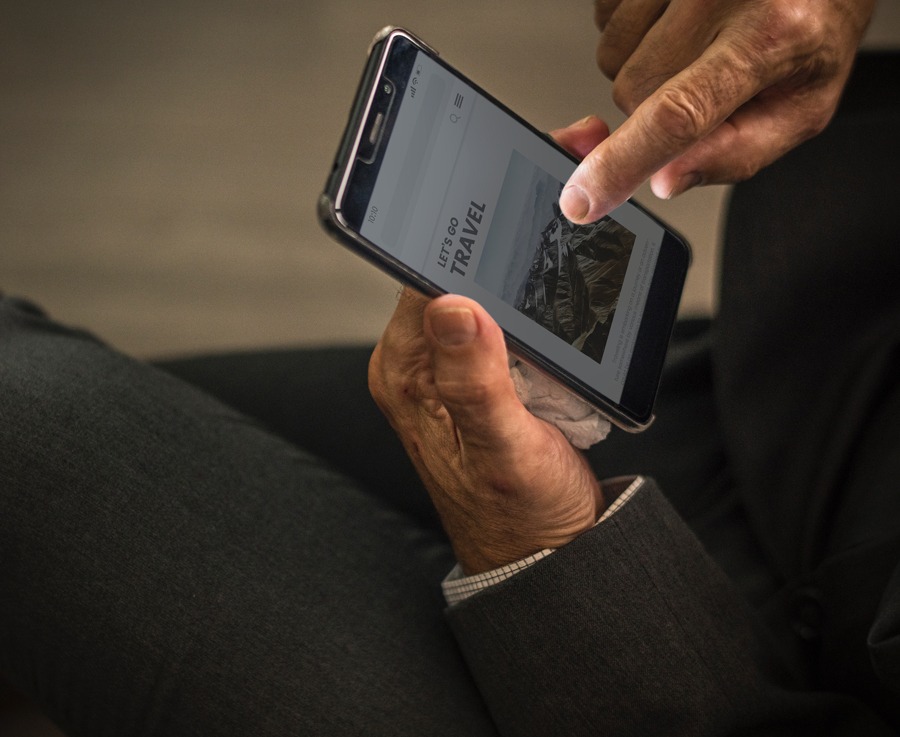I’ve written about New Year website prep before and how this is a popular time to give your website a good once-over for the new year. You can read Get Your WordPress Site Ready for the New Year: What to do Now! for some helpful ideas on getting things running smoothly. Every client that I work with has ideas about what their new or existing website needs without really thinking about what it means for their website in the long term. New or potential clients have their own misconceptions around their potential websites as well, so I thought it might be helpful to talk about some design and development myths or misconceptions and address them so you can face 2019 with some new knowledge.
Myth: Sliders and Hidden Content Are a Must
At some point in the 2000s, movement became popular in websites. The increasing adoption of JavaScript and libraries like jQuery and MooTools made things like carousels, modals, sliders and other hidden and dynamic content possible. At that time, the internet was concerned with making a splash and pushing the boundaries, not with user experience or accessibility.
Let’s make a resolution right now: no more carousels, sliders, modals or accordions. Think harder about how users interact with the web and your website and make things a little easier for everyone involved.
I often get requests for these elements with the concern that there isn’t enough room on the homepage, or that a user won’t scroll so clients want to add as much information as they can right at the top of a page. Or, they don’t want to muddy up other aspects of the website with the information they deem as less important. It’s not just sliders; it’s modals, accordions, or anything that hides content from the user initially and then reveals it with an action or timeout, or renders content directly with JavaScript.
Here’s the thing—you’re just making a mess for yourself and here’s why:
- These things split user focus. The goal of your website is (or should be) to lead your users to some kind of conversion. Sliders, for example, split the potential funnel from one to many, lowering the potential for direct conversion.
- Your SEO will suffer. Search engines rely on the idea that important website content exists “above the fold.” That is to say that Google’s algorithm expects the important content on a page to be the first thing it “sees” when it crawls your website. Shoving a bunch of mixed content into the top of a page will cause problems as search engines may not be able to determine the focus. Anything being rendered with JavaScript or hidden on load won’t even be seen by Google, and that in and of itself should concern you.
- JavaScript and images take their pound of flesh. Things that load heavy assets like images or JavaScript libraries will, no doubt, hurt you on mobile devices. Unless you know that 100% of your users are all on the best wireless networks with the fastest speed (you don’t know that), you should worry about how much you’re asking your users to load initially. Sliders and large decorative images are just unnecessary assets preventing users from getting to your website. I’ve mentioned this many times in the past, but you have seven seconds for your website to work and just as long to load your website before users will bounce.
You really don’t have to take my word for it. The research is out there. Users never like hidden content and never want to have to hunt for something. The internet would blame designers for these choices, and perhaps that’s true to some extent, but you shouldn’t need to suffer just because “it’s cool.” Before you think you NEED to play hide and seek with your content, let’s think about how else we could accomplish the same thing and save your SEO, load times, conversion rates, and users’ sanity.

Myth: External Links Should Open in New Tabs
All external links should open in a new tab.
Not only is that false, but it’s also bad practice. You may read many other posts online that suggest that this is actually the best practice, but I offer the only two reasons you should have a link open in a new tab:
- When initiating media like a YouTube video, podcast, or some event that will start a process that moving pages wouldn’t stop.
- If some function of the website requires it to function properly, and even this is a stretch. Why are you building a funky website that would require that?
The biggest reason I hear that clients want to open external links in a new tab is so that users never leave their website. The problem with that is that bounce rates are part of normal web life, and if your goal is to keep users interacting with your website, you’re actually doing the opposite.
Let me explain:
Opening a link (any link) in a new tab does a few things. It takes control from the user, disables the back button (since you’ve started a new session), removes focus from any conversion funnels you may have started a user down and you end up with a user away from your website anyway. Your website might still be open in another tab or page, but chances are that if they were just checking you out and not a returning user, you’ve lost a conversion because tabs are expendable.
Giving people the ability to return via the back button provides fewer steps to return to your website. And remember, users have the ability to open any link in a new tab, so we should give them that choice. Like I said, this is ultimately up for debate. You’ll find many people saying the exact opposite, but as someone who develops for users with accessibility considerations, this practice feels almost necessary and not something up for debate.
Browsers also behave differently by default. Some may open a new tab in the background which, for visually impaired users, means that they may not know that they’ve been redirected. Some older browsers may open target="_blank" link in a new page altogether and you might have a similar issue. From a purely business-driven sense, if your website doesn’t generate conversions or user interest organically, chances are you have other issues to resolve first.
Myth: Design First, Content Later
If you think content can come after design, you’re automatically setting yourself up for long-term failure. I often hear the words, “let’s get the design flushed out and then we write the content,” and I die a little on the inside. Design should not inform content—content, your users, conversion goals, and all of those things should influence the user interface and all aspects of design.
I wrote about ways to Plan a Website Design Your Users Will Love and content is one of the most important things to consider. Second would be knowing your users, why they are coming to your website, what they expect to find, where they expect to find it. If you try and add content to a preexisting design, you’ll always end up with a website that either doesn’t look as good as the initial design when it launches or ends up having restrictions and issues within the year, guaranteed. Content first.
Myth: Everything Needs to be Above the Fold
I mentioned above that Google expects content “above the fold,” but Google doesn’t see your website in the same way you do. They see a series of strings and markup. No visuals. They DO expect that the your headings hierarchy is set up correctly and that content appears (as far as they can tell) pertinent to the page you’re on.
There are other potential performance considerations around the idea of “above the fold,” but user interactions have changed. People scroll and have a “browse” mentality, which will typically mean that the default behavior on a website is to load and move immediately. Check your analytics and heat maps and I expect you’ll see this.
It is still important to make a big impact for your users when they visit your site for the first time, but you don’t need to inundate them with so much information. Which brings us to the next myth…

Myth: Users Don’t Scroll
They will. It’s natural. All users, even the Luddites, are curious and will scroll or move around your website.
Myth: You Have to Like Your Website
The website isn’t for you. You don’t have to like your website. The website serves a purpose for your company and is targeting your user base. You may not agree with the layout, or design elements, or other aspects of the build, but you need to look at the data. If you’re in your forties and your company intends to appeal to teens, chances are your expectations and sensibilities will differ greatly.
Look at Snapchat. The app is poorly designed. Its interface lacks intuitive markers and requires a steep learning curve, but I’m not the target demo. At 35 and male, I fall just above the vast majority of its user base of females under 34 years of age. Think about your users first and your own personal design preferences very, very last.
Myth: Web Design Is Cheap
Think about all of the services you provide your clients. Think about how you charge, how much you charge, and why you charge those amounts. You’re not giving away your products or services for any less than they’re worth. Good and considered design is the same. A UI/UX designer considers not only the design aesthetic but how users will interact with your website with purpose and help make sure that your company’s goals are taken into consideration. Sure, you can start a website with pre-built templates for a small fee, but will your users get the most out of that experience? Probably not.
Don’t be deterred by the cost of design. Have that conversation nonetheless and hear them out. It will be well worth the cost. I’m sure of it.

The Takeaways
Not all myths are made up. Several of these items above were, at one point in history, common or even best practices. Times have changed. More emphasis has been added to user experience and accessibility. Constant exposure to technology has provided everyone with a default set of interactions and expectations around your website and how it should work. This is one of the main reasons we suggest a website be redesigned or rebuilt every two-five years.
Certainly there are always exceptions to the rule, but hopefully, these myths will no longer impact your website design decisions or expectations and we can all move forward building a better internet for all.
I skipped straight down here before reading the rest of the post, and I say this as a USER… external links that hijack your browser away from the current page (I would say unexpectedly, but this is ALWAYS unexpected behaviour) is a blight and a stain and a horrible experience. If i somehow forget to define that an external link should be in a new tab in my own work, then I feel terribly embarrassed and remedy immediately. If I come across it in someone else’s, I feel frustrated to have experienced it, and also judgemental against their erroneous / shoddy workmanship for allowing it.
That’s certainly just one guy’s 2019 opinion, but one I feel super strongly about.
Hmm, I have one other point about sliders and hidden content… I too am very reserved about the employment of hidden content techniques in websites, but the real issue here is that it’s got to be done right, and for the right reasons. Seeing headlines, for example, of deeper articles can be very useful. Imagine if a News website showed every story with its full content on the front page. That would be literally horrible.
As for sliders, I still think they can be pretty useful, as long as they have a well designed UI, can be instantly scrolled through manually by the user (particularly back to one that just went past), preferably in both directions, and in carousel (i.e. the end and start loop round to one another), and ideally, you can see the volume of slides (perhaps on hover), and where you’re up to in the loop.
As for modals… those obtrusive, browser hijacking, tactical warfare ones that pounce on your face and force you with undesirable ultimatums or cold-call marketing and requests – they are probably among the worst web-interaction experiences I can think of, and I often find myself having to developer-tools-hack them away to access website content without interacting with them in the way they want me to. Though, I do acknowledge that in some ‘user-initiated’ scenarios, they can be useful for revealing hidden away tools or information that would not be appropriate to show all the time. For example, additional small snippets of information, an brief submission form or control interface, or what-have-you, though I would be very careful to determine that this was the ideal method for delivering such content or tools, and I would most likely lean toward it NOT being ideal.
As for the point about content first… as a designer and developer, I would say it really has to depend on a lot of factors – some of which you’ve eluded to. I feel like most often the existing or planned content should ideally inform elements of the design, and possibly in the reverse. Though mostly, the design of the site would be intended to ‘support’ whatever content the website may start with or end up with at any point… and preferably define the rules for what type of content should and may be created and how… though more in an informative sense, than necessarily a limiting sense. The design should ideally set the scene for any content that may be created, and preferably inform or assist content creators with the process, where appropriate. To suggest that it’s always going to be a ‘content first’ approach, however, seems somehow based toward the content creation perspective or role, and somehow naiive. Sometimes a website may be designed to have rapidly changing or unexpected content, or perhaps the content is particularly non-visual or unpredictable in nature. Who can say, and that’s the point I’m getting at… there’s myriad types of website and design process, where you can’t just go and say, “Content first, always”, I feel.
I have to say I agree with most of the other points on the article though – well done, and a useful read. =)